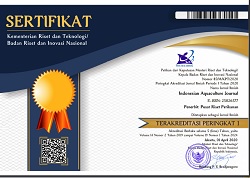FEEDING INCIDENCE, GROWTH AND SURVIVAL RATE IN THE EARLY STAGE OF THE RED-SPOTTED GROUPER, Epinephelus akaara, IN RELATION TO TANK COLOR
Abstract
The red-spotted grouper, Epinephelus akaara, is one of marine fish species targeted for mariculture in Japan. The artificial mass seedling production of these species has been largely successful. However, the survival is still unstable. The effect of tank colors on the feeding incidence, feeding proportion, growth and survival rates in the early stage of the red-spotted grouper were examined. The results showed the feeding incidence, feeding proportion, growth, and survival rates at different tank colors were highly significantly different (P<0.001). Post hoc multiple comparisons based on Tukey’s test showed significant differences (P<0.05) regarding feeding incidence between yellow (70.45%) compared to white (55.83%), black (48.42%), green (41.67%), blue (35.17%), and red (32.50%). The highest feeding proportion (number of rotifer in the stomach/larvae) was found at yellow (5.62), followed by white (2.47), black (1.97), green (1.92), blue (1.71), and red (1.28). The specific growth rate showed significant differences (P<0.05) were found at yellow (2.14%) and white (1.84%) compared to black (1.46%), green (1.20%), blue (1.15%), and red (1.13%). The survival rate at yellow color (1.22%) was the highest, followed by white (1.09%), black (0.79%), green (0.57%), blue (0.38%), and red (0.37%). Yellow was suitable as tank wall color for rearing of red-spotted grouper larvae.
Keywords
tank color; growth; survival; larvae; grouper
Full Text:
PDFDOI: http://dx.doi.org/10.15578/iaj.1.2.2006.121-128

Indonesian Aquaculture Journal is licensed under a Creative Commons Attribution-ShareAlike 4.0 International License.
















_25.jpg)


